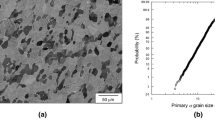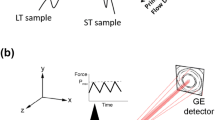Abstract
A technique to determine the crystallographic orientation of the fracture facets has been described. The spatial orientation of the facet plane is determined in a scanning electron microscope (SEM) using a quantitative tilt fractography technique. The crystallographic orientation of the grain, across which a particular fracture facet had been produced, is determined using the electron backscattered diffraction (EBSD) technique in an SEM. These two pieces of information were combined to obtain the crystallographic orientation of the fracture facet normal. This technique was used for the characterization of dwell-fatigue fracture facets at the crack-initiation site in Ti-6242 alloy. Our results indicate that these facets are not exactly aligned with the basal plane, but are inclined at ∼10° to it.







Similar content being viewed by others
References
Davidson DL, Eylon D (1980) Metallurgical Transactions 11A:837
Bache MR, Davies HM, Evans WJ (1995) Titanium ’95: Science and Technology, p 1347
Bache MR, Evans WJ, Davies HM (1997) Journal of Materials Science 32:3435
Woodfield AP, Gorman MD, Corderman RR, Sutliff JA, Yamrom B (1995) Titanium ’95: Science and Technology, p 1116
Sinha V, Mills MJ, Williams JC (2004) Metallurgical and Materials Transactions 35A:3141
Themelis G, Chikwembani S, Weertman J (1990) Materials Characterization 24:27
Semprimoschnig COA, Stampfl J, Pippan R, Kolednik O (1997) Fatigue & Fracture of Engineering Materials & Structures 20(11):1541
Davies PA, Randle V (2001) Journal of Microscopy 204(Pt 1):29
Slavik DC, Wert JA, Gangloff RP (1993) Journal of Materials Research 8(10):2482
Sinha V, Mills MJ, Williams JC (2006) Metallurgical and Materials Transactions 37A: 2015–2026
Wright SI (2000) In: Schwartz AJ, Kumar M, Adams BL (eds) Electron backscatter diffraction in materials science. Kluwer Academic/Plenum Publishers, New York, NY, p 51
Blackburn MJ, Williams JC (1969) Metallurgical aspects of the stress corrosion cracking of Titanium alloys,” Proc. Conf. on the Fundamental Aspects of Stress Corrosion Cracking, N.A.C.E., p 620
Davies PA, Novovic M, Randle V, Bowen P (2002) Journal of Microscopy 205(Pt 3):278
Acknowledgments
This research was supported by the Federal Aviation Administration. The authors thank the Technical Monitor, Joseph Wilson, for his encouragement and support of this work. The donation of Ti-6242 pancake forging by Ladish Co. Foundation (Cudahy, WI) is also gratefully acknowledged.
Author information
Authors and Affiliations
Corresponding author
Rights and permissions
About this article
Cite this article
Sinha, V., Mills, M.J. & Williams, J.C. Determination of crystallographic orientation of dwell-fatigue fracture facets in Ti-6242 alloy. J Mater Sci 42, 8334–8341 (2007). https://doi.org/10.1007/s10853-006-0252-z
Received:
Accepted:
Published:
Issue Date:
DOI: https://doi.org/10.1007/s10853-006-0252-z




